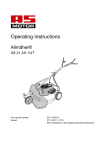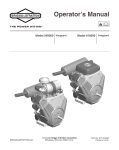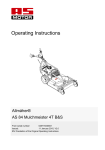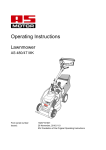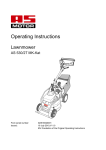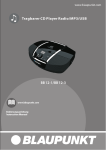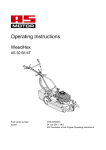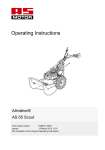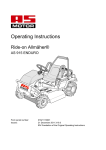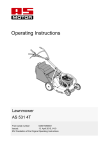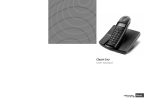Download Operating Instructions
Transcript
Operating Instructions Mulchmeister AS 84/2 LB From serial number: Issued: 014710020001 04 July 2011, V8.0 EN-Translation of the Original Operating Instructions Preface Intended use Please fill in all data referring to your device. When ordering spare parts, provide your dealer with the device and engine number. The device is exclusively intended for cutting grass or similar vegetation in well maintained areas in agriculture, forestry, and landscape conservation that are mowed at least once a year. Serial number: Engine number: Date of purchase: Address of dealer: Dear customer: Only use attachments and cutting tools authorised by “AS-Motor Germany”. Any use exceeding this purpose is inadmissible. The manufacturer is not responsible for any damage resulting from this. Observe the required maintenance and repair measures. The user of the device is responsible for accidents or damage to other persons or their property! Congratulations on your purchase. You have acquired a reliable quality product by “ASMotor Germany”. The device must not be used: This product has been manufactured according to modern manufacturing methods and comprehensive quality assurance measures. Only when you are satisfied with your device, we have attained our goal. Read these operating instructions carefully and attentively so that your device operates smoothly and you and others are safe from any hazards. If you have questions concerning your device, please contact your dealer or call our customer service (telephone +49/(0)7973/9123-0). For international AS partners, please see: www.as-motor.de/worldwide. “AS-Motor Germany” wishes you much joy with your new device. 2 To cut hard objects, rocks, rubble, or pieces of wood. To trim bushes, hedges, and shrubbery. To cut plants in flower pots or planters or on rooftops. To clean (vacuum) footpaths. As shredder for shredding tree and hedge cuttings. As drive unit for work tools and any type of tool sets that are not authorised by “AS-Motor Germany”. Contents Preface ......................................................... 2 Intended use ................................................ 2 Explanation of the symbols........................ 4 Symbols in the instructions ........................ 4 Symbols on the device .............................. 4 Safety instructions ...................................... 5 Get informed! ............................................. 5 User restrictions and hours of operation ... 5 Safe handling of fuel .................................. 5 Check the device prior to use .................... 6 Use caution during operation .................... 6 Prior to mowing.......................................... 6 Use caution when mowing ........................ 6 When work is completed ........................... 7 Use caution during maintenance and repair8 Device description ...................................... 9 Control elements ....................................... 10 Assembly ................................................... 11 Scope of delivery ..................................... 11 Unpacking................................................ 11 Guide bar and handlebar ......................... 12 Transport.................................................... 12 Information on mowing............................. 13 Prior to starting ......................................... 13 Fuel.......................................................... 13 Tanking up ............................................... 13 Checking engine oil level ......................... 13 Adjusting cutting height ........................... 13 Switching off and parking ........................ 15 Maintenance and clearing ........................ 16 Preparations ............................................ 18 Cleaning the device ................................. 18 General inspection .................................. 18 Chain lubrication...................................... 18 Transmission ........................................... 18 Maintaining the engine ............................ 18 Checking the engine oil level .................. 19 Checking the spark plug .......................... 19 Cleaning the air filter ............................... 19 Checking the drive................................... 19 Checking the parking brake..................... 19 Checking the blade.................................. 20 Storage ....................................................... 20 Storing the device.................................... 20 Longer storage ........................................ 20 Restarting ................................................ 21 Spare parts ................................................ 21 Wear parts.................................................. 21 Accessories ............................................... 21 Disposal ..................................................... 22 Warranty..................................................... 22 Troubleshooting ........................................ 23 Technical data ........................................... 26 Declaration of conformity......................... 27 Starting ....................................................... 14 Starting the device ................................... 14 Engaging the blade ................................. 14 Oil pressure switch .................................. 14 Driving ........................................................ 15 Driving ..................................................... 15 Reverse gear ........................................... 15 Steering and turning ................................ 15 3 Prior to any repair and maintenance work, pull off the spark plug connector. Explanation of the symbols Symbols in the instructions In these operating instructions, the following symbols are used to denote special dangers. Warning. These symbols denote special dangers. Clean the ventilation grid! The cooling air of the motor is sucked in through the ventilation grid of the engine cover. Always keep the entire surface open and free! Prohibition sign. These symbols denote inadmissible procedures. Directive sign. These symbols denote required protective measures. Noise is causing health problems. Use personal ear protection to avoid hearing damage. Symbols on the device The following symbols are placed on the device to inform you must be careful and attentive when using the device: Working with the device requires extreme cautiousness. Read the operating instructions before you use the device. Risk of injury! Make sure that no one is within the danger zone of the device. Objects may be ejected. The danger zone extends for at least 50 metres. Min. 50 m. The quickly rotating blade can cause life threatening injuries or immense property damage! Be especially careful to keep your hands and feet away from the blade when the device is put into operation. 4 Type plate The type plate on the device provides you with information on the device type and the technical data. 1 2 3 4 5 6 7 AS-MOTOR GERMANY GmbH & Co KG Ellwanger Stra ße 15 D-74424 Bühlertann Rasenm äher AS 53 B6 RB-Kat 4,4 kW (6,0 PS) / 2800 (1/min) 68 kg 2011 SNR: 020909090055 1003s 8 1 2 3 4 5 6 7 8 Name and address of the manufacturer Device designation Type designation Rated power output in kW / engine speed Weight Year of manufacture Serial number CE marking Safety instructions Use gloves and avoid skin contact with the fuel. Get informed! For your safety, read these operating instructions with care. Familiarize yourself with the control elements and the proper use of the device. Share these operating instructions with other users of the device. Before you use the device for the first time, let the dealer instruct you regarding safe use. User restrictions and hours of operation Never give your children or other persons who are not familiar with the operation instructions permission to use the device. Persons under 18 years old may operate the device only under supervision. Local regulations will determine the minimum age of the user and the hours of operation. Unsuitable for the operation of the device are persons Who are under the influence of alcohol, drugs, or medicine that slows down reaction time. With physical and mental impairments. People fitted with pace makers are not allowed to touch any current carrying parts of the ignition system. Safe handling of fuel Danger! Fuel is toxic and highly inflammable. Danger of fire and explosion! Keep the fuel away from ignition sources and do not smoke while handling the device. Do not inhale fuel vapours; they are dangerous to your health. Fuel up outdoors only when the engine is cool and not running. Use a filler or funnel. Do not spill any fuel and do not let the fuel get into the canalisation or ground water. If you spilled fuel, do not start the device until the fuel vapours have evaporated (wipe dry). Move the device away from the area where the fuel was spilled. Always close the tank cap securely and do not open it while the engine is running or the device is still hot. Drain the fuel tank only when outdoors. Use a suitable container or run the tank empty. Keep the fuel away from children and store it in a suitable container in a dark, cool, and dry location. Never park the device with fuel in the tank inside a building where fuel vapours could come in contact with open fire or sparks. Immediately replace a damaged fuel tank or tank cap (authorised dealership). First aid When swallowing fuel or inhaling fuel vapours, do not force vomiting and immediately consult a doctor. In case of skin contact, immediately wash with water and soap. Change your soiled clothing as soon as you can. Measures in case of a fire In case of a fire, use foam, dry powder extinguisher, or carbon dioxide (CO2). Never douse with water! 5 Check the device prior to use Prior to use, check by visual inspection blade, protection skirt, drive and fastening parts for proper condition and firm seating. Switch off the engine and wait until the blade comes to a standstill, and pull off the spark plug connector before you clean or check the device or before you carry out work on the device. before you unblock or unclog the discharge area. Never use the device if covers, protective skirt, or protection bow are defective. Do not remove, change or override any safety devices or control elements. Prior to mowing Observe the maintenance instructions and replace damaged or worn parts immediately. Have an authorised service centre check your device if the blade does not stop within 7 seconds. Use caution during operation Do not start the engine: if fuel was spilled. in closed or poorly ventilated rooms (danger of poisoning!). if there are other persons nearby. Personal protective measures While mowing, always wear sturdy footwear with good grip, long trousers, and gloves. Do not mow in open sandals or bare feet. Noise is causing health problems. Use personal ear protection to avoid hearing damage. Wear safety glasses and headgear. Preparing the mowing area Only start the device when your feet are at a safe distance to the blade. Prior to mowing, carefully check the perimeter of the lawn. Remove rocks, pieces of wood, bones, wires, and other objects that could be picked up and thrown out by the device. During startup of the engine, do not tilt the device. Use caution when mowing Do not touch the engine or the silencer. They become very hot during operation and you can get burned. Resulting unintentional movements constitute an additional injury hazard. Switch off the blade and wait until the blade comes to a standstill before you move over surfaces other than grass. Switch off the engine and wait until the blade comes to a standstill 6 before you tilt or transport the device. if you step away from the device, even for just a short time. before you adjust the cutting height. before you refuel. Risk of injury Always stay within hearing range to other persons who can assist you in case of an emergency. Danger! Risk of injury caused by thrown out objects. Never mow while persons, children, pets, or property are in the vicinity. The danger zone extends for at least 50 metres. The area in front of and to the right of the device is especially dangerous. Keep your hands and feet away from rotating parts. Keep your distance to the discharge area when you work with the device. Mow only in daylight or good artificial light. Avoid mowing wet grass slipping hazard. Be extremely cautious when turning the device round or pulling it toward you and when moving in reverse. Always walk slowly! Never lift or carry the device when the engine is running. When using the device over a longer period of time, vibrations can cause disturbances in the blood supply of the hands. A generally accepted usage time cannot be determined. Use gloves. Take breaks on time. Have an authorised service centre check the device immediately if the blade hit an object. if the device starts to vibrate unusually severely. Caution when mowing slopes Devices fitted with a four stroke engine may only be operated on less than 20°slopes (see chapter Oil pressure switch). When mowing slopes, there is a risk of slipping and tilting! Only mow steep slopes when safe operation assured. Do not mow excessively steep slopes. When mowing steep slopes, meet the appropriate safety measures, e.g. use step irons. Always mow in horizontal directions, never up- or downwards. Sure footing is essential for your safety, always wear skid proof safety shoes. Be extremely careful when changing the direction. Only mow when the surface is dry and non-slip. The device can roll away when you mow downhill. Put the device down on even surfaces only and prevent inadvertent rolling. Mowing surfaces with fire hazard Carry a sufficient amount of suitable extinguishing agent. If side inclination is too great, fuel may leak from the carburetor or the tank. This poses a fire hazard! Observe the mowed surface also after moving is completed to ensure that no fire will start. To avoid risk of fire, keep the following components free of dirt, grass, hay, leaking oil, grease, etc.: Engine Silencer (manifold, guard, clearances) Area around the fuel tank When work is completed After mowing, always close the fuel valve and the tank ventilation. Prior to leaving the device, wait until the blade comes to a standstill and pull off the spark plug connector. After switching it off, let the device cool down for at least 20 minutes before you store it in a dry, closed, sufficiently ventilated room. Never store the device when there is fuel in the tank inside a building where fuel vapours might come into contact with open fire or sparks. 7 Use caution during maintenance and repair liable for damages that were caused by our devices if Only carry out maintenance work as described in these operating instructions. Have an authorised service centre carry out all other work. Prior to starting any maintenance work, wait until the engine comes to a standstill and pull off the spark plug connectors. We explicitly point out that, in accordance with the Product Liability Act, we are not 8 worn or damaged parts were not repaired or replaced on time these damages were caused by improper repair. when changing a part, our original parts or parts authorised by use were not used. the repair work was not carried out by an authorised service station. The same applies for spare parts and accessories. Device description 9 10 11 12 8 2 13 14 15 16 7 17 6 18 5 19 4 3 14 1 1 Steerable front wheel 13 Ventilation grid 2 Type plate 14 Spark plug connector (2 connectors) 3 Air filter 15 Choke 4 Oil dipstick 16 Silencer 5 Starter grip 17 Cutting height adjustment 6 Fuel valve 18 Protection bow 7 Height adjustment of handlebar 19 Protection skirt 8 Switching lever 9 Handlebar console 10 Lever for lateral adjustment of handlebar 11 Tank ventilation 12 Tank filler spout 9 Control elements 7 6 8 I 3 M 5 2 Disengaging blade (0): Release the blade clutch lever and set the accelerator lever to MIN. 1 6 4 Throttle lever (1) With the accelerator lever, you change the engine speed and thus control the engine output. Lever for lateral adjustment of handlebar (4) 1. Release the eccentric tension lever. 2. Attention: Do not crush the Bowden cables when pivoting the handlebar. Swivel the handlebar to the side to the desired position. 3. Clamp the handlebar with the eccentric tension lever. MAX: Full throttle MIN: Neutral position Drive lever with parking brake (2) With the drive lever, you switch the drive and the parking brake on and off. Drive on / parking brake off (I): Press the lever towards the handlebar and continue to hold. Drive off / parking brake on (0): Release the lever. Blade clutch lever (3) The blade clutch lever is a safety device. When you release the lever the blade comes to a standstill within 7 seconds. 10 0 Engaging blade (I): Lift the blade clutch lever, engage the latch knob (8) and press the blade clutch lever towards the handlebar. Height adjustment of handlebar You adjust the height of the handlebar with the screw for the height adjustment of the handlebar (see Assembly). Engine stop switch (5) With the engine stop switch, you switch the ignition on and off. If you switch off the ignition, the engine stops. 0: OFF I: ON Steering brake levers (6) Choke Use the two steering brake levers to control the travel direction of the device. Close the choke for cold engine start. Opening the choke: Push the wire ring inward. Swivelling to the right: Press the right lever toward the handlebar Swivelling to the left: Press the left lever toward the handlebar Closing the choke: Pull the wire ring outward. Fuel valve 1: Closed 2: Open 1 Start button (7) 1 Press and hold the start button during the starting procedure (see Starting). Switching lever The transmission has 5 forwards gears, neutral position, and one reverse gear. For switching, release the drive lever, switch to the next gear and continue to drive. 2 Assembly Scope of delivery The device is delivered in a carton. The scope of delivery includes: The device. These operating instructions. Warranty card. Tool bag. Unpacking R: N: 1: 2: 3: 4: 5: Driving in reverse Neutral position Driving forwards Driving forwards Driving forwards Driving forwards Driving forwards 1.90 km/h 0 km/h 1.25 km/h 1.65 km/h 2.50 km/h 3.80 km/h 4.80 km/h 1. Open the box at the top. 2. Cut open the front side of the box. 3. Bring the handlebar up (see guide bar and handlebar). 4. Check the air pressure in the tires (see Technical data). 5. Switch the switching lever at the transmission to neutral position. 6. Press the drive lever towards the handlebar and push the device off the pallet. 11 Guide bar and handlebar Transport Warning! Risk of injury due to the heavy weight of the device. The device can fall over and fall down and cause severe injuries. Observe the following notices. Transport the device on a freight vehicle or a trailer which is designed for a carrying capacity of at least as great as the empty weight of the device. 1 Prior to transport, let the device cool down for at least 20 minutes. Close the tank ventilation and the fuel valve. 1. Slacken the screw (1) at the guide bar and pull it out sideways. 2. Turn the handlebar and guide bar to the correct position. 3. Fix the handlebar to the guide bar with the screw (1). 3 For transport, you can fold up the handlebar. Loading Use suitable ramps for loading that can carry the empty weight of the device + 100 kg. are wider than the device. have a slip-free surface. 1. Put the device in front of the ramps and make sure that the ramps - are as wide as the wheel gauge of the device. 2 4. 5. Slacken the screw for the height adjustment of the handlebar (2) and pull it out sideways. Attention: Do not crush the Bodwden cables (3) when swivelling the handlebar. Swivel up the handlebar to the correct working position and tighten with the screw and nut. - are tightly secured to the platform. - are not steeper than 15°. 2. Carefully drive the device via the ramps onto the platform. 3. Secure the device with belts to the frame elements that can hold the weight. 4. Secure the device against rolling, sliding, tilting, and fuel and oil leakage. Unloading the device 1. Undo the transport fastenings. 2. Drive the device carefully down the ramps of the platform. 12 Information on mowing Prior to starting Prior to mowing, check your device for completeness, proper functioning, and cleanliness. A dirty ventilation grid can damage the engine and a dirty protective grid at the silencer poses a fire hazard. Fuel Frequent engagement and disengagement of the clutch increases wear of the blade drive belt and the blade brake. Especially in case of high grass, clutch engagement leads to overload. To keep the area well maintained, mow frequently and keep the grass short. Only mow with a sharp and undamaged blade. Have the blade sharpened and balanced regularly (by authorised service centre). As fuel, use unleaded petrol (see operating instructions of the engine manufacturer). Tanking up Danger! Fuel is ignited by hot engine parts. Prior to filling up, switch off the engine and wait for at least 20 minutes until the engine has cooled down. Observe the safety instructions regarding the fuel! Filling in the fuel: 1. For filling, use a canister with a filler spout or use as funnel. Do not mow when the grass is wet or when it is raining. The turf may be damaged and there is a danger of slipping! 2. Open the canister carefully so that the existing overpressure is discharged slowly and no fuel spurts out. Turn the device around only in already mown sections. Do not leave the device unattended while the engine is running. 3. Open the tank cap carefully so that the existing overpressure is discharged slowly and no fuel spurts out. For mowing, always turn the accelerator lever to full throttle to achieve the best mowing performance. 4. Fill the fuel tank. 5. Screw the tank cap on tightly. Checking engine oil level Attention! Prior to each use, check the engine oil level (see operating instructions of the engine manufacturer). To avoid blockage during the ejection of grass, we recommend, for flat terrain, to proceed according to the mowing patterns. Mulch is shredded into much smaller pieces when you mow the terrain once again in the opposite direction. If the grass is extremely high, mow twice at different cutting height settings. Adjusting cutting height Adjust the cutting height setting only when the engine is switched off. Set the cutting height so that the blade does not touch the ground even in case of terrain unevenness. If the cutting height is set too high, objects can be ejected and the “clean cut appearance” can be destroyed. 13 1 5. For cold start, close the choke. 6. Put the accelerator lever to medium engine speed position. 7. With your left thumb, press the start button and continue to hold. 8. Pull the starter point slowly out until you feel resistance then pull out quickly – engine starts to run. 9. Let the starter rope retract slowly. 10. Release the start button. 1. Switch off the engine and wait until the blade comes to a standstill. 2. Pull the lever (1) upwards and turn it until the desired cutting height is reached. 11. Open the choke again. 12. For mowing, set the accelerator lever to the maximum speed. Engaging the blade Starting Danger! During startup, there is a risk of injury caused by the rotating blade. Make sure that no one is within the danger zone of the blade. Do not tip the device over to one side during startup. Danger! If after startup the carburetor does not close properly, fuel will overflow and a fire hazard occurs. Close the fuel valve and contact an authorised service centre. Starting the device 1. Place the device onto a flat surface, not in high grass. 2. Open the fuel valve and the tank ventilation. 3. Plug on the spark plug connector. 4. Set the engine stop switch to "I". 14 1. Lift the blade clutch lever. 2. Press the latch knob at the blade clutch lever. 3. Press the blade clutch lever towards the handlebar – the blade starts to move. Disengaging the blade when moving over paths: 1. Release the blade clutch lever. Oil pressure switch The oil pressure switch of the engine shuts off the engine if damage of the engine caused by inadequate oil pressure is likely to occur. This can be the case when: The oil level is too low. The device is in an extremely inclined position in excessively steep terrain. To restart the engine, the device must be positioned on an even surface. Always check the oil level. Driving Driving In case of a hazardous situation, switch off the drive and declutch the blade. Drive on: 1. Engage the desired gear. 2. Press the drive lever towards the handlebar - device is moving. 5. Press the drive lever towards the handlebar - device moves in reverse. Steering and turning To control the direction of travel, a steering brake is installed at each rear wheel. The steering brake works also when moving in reverse. Moving to the right: Drive off: 1. Release the drive lever. Pull the right steering brake lever. The right wheel is braked. Moving to the left: Adjusting the driving speed: Pull the left steering brake lever. The left wheel is braked. The driving speed depends on the quantity and thickness of the growth. If the growth is especially high and thick, you can mow at low driving speed only. Moving straight ahead: 1. Release the drive lever. Stopping: 2. Engage the desired gear. 3. Press the drive lever back towards the handlebar – device is moving. Reverse gear Danger! Risk of injury caused by slipping or tripping during moving in reverse or turning. When moving in reverse, always switch off the blade! If both steering brake levers are in rest position, both wheels rotate at the same speed. If both steering brake levers are pulled, the device stops. Turn the device only on already mowed grass. Switching off and parking Caution! On a slope, the device can roll away. Put the device on even ground only or secure it against rolling away. Prior to switching on the reverse, make sure that path is free of obstacles. Especially when going over already mowed grass ensure safe footing. 1. Release the drive lever. 1. Release the drive lever. 3. Turn the engine stop switch to "0". 2. Disengage the blade. 4. Wait until the blade comes to a standstill before you step away from the device. 3. Set the accelerator lever to medium speed. 4. Set the switching lever to reverse (R). 2. Turn the accelerator lever to the lowest engine speed. 5. Close the fuel valve and the tank ventilation. 6. Pull off the plug connector. 15 Maintenance and clearing by the warranty. Operational safety is endangered as well. Regular maintenance keeps your device ready for use. Contact your authorised service centre for checkup if you detect problems during maintenance. If you do not observe the maintenance notices, faults may occur that are not covered Component Device Action Maintenance interval Before and after each use Annually or every 50 h Check for safe working condition. ■ ▲ Clean. ■ Customer service. Fuel ▲ Check fuel level. ■ Is the tank cap closed? ■ Tank, fuel valve, and fuel line Check parts for leaks and check for good condition. ■ ▲ Carburetor Does the carburetor close again after starting? ■ ▲ Ventilation grid Clean. ■ ▲ Engine cooling Clean. Spark plugs Check/adjust. ▲ ■ Replace. Air filter Check/clean. ■▲ ■ Replace. ▲ ■▲ Blade and fastening components Check for wear and damage. See chapter Checking the blade. Blade brake Does the brake function properly and does the blade stop within 7 seconds? □ ▲ Drive lever Does the device stop when the lever is in zero position? □ ▲ V-belt Are the V-belts tensioned correctly, without fissures, and in good condition? 16 ■ Change. ▲ ▲ ▲ Component Action Maintenance interval Before and after each use Annually or every 50 h Bowden cables Check for proper function and ease of movement. ■ ▲ Acceleration lever Check for proper function. □ ▲ Chassis and impact protection Check for rust and fissures and check the welding seams. ■ ▲ Are all protective device fastened correctly and properly functioning? ■ ▲ Label Condition of the labels. ■ ▲ Engine See operating instructions of the engine manufacturer. ■ ▲ Check oil level (see operating instructions of the engine). ■ ▲ Oil change. ▲ Parking brake Check the parking brake. ■ ▲ Flammable material Remove easily flammable debris buildup from the engine and the device. ■ ▲ Tires Check tires and tire pressure if necessary. ■ ▲ ■ □ ▲ By the user when the engine is not running. By the user when the engine is running. By the authorised service centre. 17 Preparations Chain lubrication Prior to all maintenance and cleaning work: 1. Let the device cool down for at least 20 minutes. 2. Pull off the two spark plug connectors. 3. Close the fuel valve and the tank ventilation. 4. For work on the bottom of the device, tilt the device backwards until the engine support rests on the ground. Cleaning the device After each use, you should clean the device thoroughly, especially the bottom side and the blade. Stuck grass or dirt affect the grass discharge and the cutting quality. For a sufficient engine cooling, keep the engine cover, ventilation grid, and the engine clean. Fire hazard! Pay special attention so that components at the silencer are clean. For cleaning use a hand brush. Remove stubborn soiling with a wooden or plastic spatula. Clean the outer housing parts with a cloth. Do not rinse off the device with a water jet or high pressure cleaner! Do not use aggressive cleaning agents. General inspection To ensure proper working order of the device, regularly check all nuts, bolts, screws, fuel line connections, air filters, etc. for firm seating. Check the ignition cable and the spark plug connectors for damages. Change the damaged or used parts especially covers, protection skirt, silencer, or fuel immediately (authorised service centre). 18 The chains on the right and left of the differential lock must be lubricated on a regular basis. We recommend the use of biodegradable chain spray. Transmission The transmission is maintenance-free and filled with oil that is supposed to last the entire service life of the device. Make sure that there are no leaks or damages. Maintaining the engine Danger! If the speed of rotation is set too high, objects can be ejected. The engine can be damaged and noise pollution increases. Do not change the basic setting of the carburetor or the speed control. The operating instructions of the engine are prepared by the engine manufacturer. They contain the maintenance instructions and the warranty conditions for the engine. If warranty work for the engine is required, please contact your authorised service centre or the nearest authorised engine dealer. Checking the engine oil level For this, observe the attached operating instructions of the engine. The oil level must remain between the two markings of the oil dipstick. Make sure that the oil level is never below the bottom marking; otherwise the engine can be damaged. Never fill in oil above the top marking. Otherwise, there is a risk that the oil enters and destroys the air filter. Checking the spark plug Danger! The ignition system generates an electromagnetic field. Wearers of pacemakers must not work on live parts. Soiled spark plugs reduce the engine output. Clean the electrode of the spark plug with a brass wire brush. Check the electrode gap (see operating instructions of the engine manufacturer). Make sure that the insulator around the electrode is not damaged. Never use a damaged spark plug. For this, observe the attached operating instructions of the engine. Checking the drive 1. Put the device on a non-slip surface (e.g. concrete or asphalt). 2. Switch off the engine. 3. Set the switching lever to a forward gear. 4. Actuate the drive lever. 5. Try to pull the device backwards. If the rear wheels lock, the drive is correctly adjusted. If you can pull the device, the drive must be re-adjusted. 1 Tighten the spark plug using the correct torque (see operating instructions of the engine manufacturer). Always check both spark plugs. Cleaning the air filter Danger! Cleaning agents pose a fire and explosion hazard. Never clean the air filter with flammable solvents. Always make sure that the air filter is clean. A dirty air filter affects the engine output and increases the fuel consumption. Independent from the number of operating hours the filter inserts should be changed at least annually. Do not operate the engine without air filter. Re-adjusting the drive Turn the adjusting screw (1) at the drive so that the wheels lock, while the drive is actuated, when the device is pulled. If there is no improvement after the adjustment, have the device checked by an authorised service centre. Checking the parking brake 1. Put the device on a non-slip surface (e.g. concrete or asphalt). 2. Switch off the engine. 3. Switch the switching lever to neutral position. 19 4. Try pulling the device backwards. If the rear wheel lock, the parking brake is correctly adjusted. If the device can be easily pulled backwards, the parking brake must be re-adjusted. Contact an authorised service centre to do so. Checking the blade Danger! Improperly mounted and maintained blades pose a severe injury hazard. Work at the blade shall only be performed by an authorised service centre. Work on the blade requires special qualifications because an unbalance test is required and the torques must be observed. Before and after each mowing operation and in case of significant changes, check for wear, damages, and cracks. Vibrations indicate that the blade or the mulching blade is worn excessively or on one side only. Improperly sharpened blades or mulching blades increase the device load and result in fatigue cracks and breakage! Ejected pieces can cause severe injuries. Blade change 2 1 It is absolutely necessary to change the blade: When one of the wear markings (1) was reached. Original blade are engraved with wear markings (marking in form of a ball-shaped imprint on the rear side of the blade). When the thickness of the blade at the rear edge of the vane (2) or at another point is below 1 mm (exception: cutting edge). At the least once per year or every 50 operating hours, whether there is wear or not. The material deteriorates, may show cracks and this can endanger persons and material goods. An original AS blade can be recognised by these imprints: XXXX corresponds to the spare part number. Checking the blade clutch Check the blade clutch for proper function by disengaging the blade. The blade must come from full speed to a standstill in less than 7 seconds. Contact an authorised service centre if this is not the case. Storage Storing the device Keep the device in a closed, dry, and well ventilated room and out of reach of children. Always eliminate all problems of the device before you store it so that the device is always in a safe-to-operate state. Let the engine cool down before you store the device in closed rooms. Longer storage 1 20 2 1. Observe the safety instructions regarding the handling of fuel. 2. Draining fuel tank: Put a piece of a tube on the fuel valve and fill the fuel in an adequate fuel container. Inform your authorised service centre about the device type and serial number of your devices when you order spare parts. 3. Emptying carburetor: Start the engine and let it run until it stops on its own. 4. Clean the device thoroughly. 5. Touch up defects in painting (for spray paint, see Accessories). 6. Preserve the engine: - Unscrew the two spark plugs. - Fill a tablespoon of engine oil into each spark plug opening. - Briefly actuate the starter (oil is distributed in the cylinder). Wear parts Some parts are wear parts. They wear during use and must be replaced. The warranty does not cover the following parts: Blades, cutting blades, cutter bars, blade bolts, sliding plates, V-belt, chains, Bowden cables, starter ropes, pressure plates, air filters, spark plugs, disc springs, lock washers, fuses, discs, thrust plates, pressure discs, protection skirts, impact protection, wheels, tires. - Screw the spark plugs back in. - Do not put the spark plug connector on! In autumn, have your device checked by an authorised service centre! Also observe the notices on storage in the attached operating instructions by the engine manufacturer. Accessories Twin tires E09301 Spray paint 400 ml, colour orange E04606 Operating hours counter E10740 Puncture protection: specialist dealer Restarting Spark extinguisher: engine manufacturer (through specialist dealer) If you want to start the device after a longer storage, carry out the tasks described in chapter Maintenance. Operating hours counter E10740 Spare parts The reliable and safe operation of the device also depends on the quality of the spare parts used. Only use original spare parts and accessories that were approved by “AS-Motor Germany”. When foreign parts are installed, the warranty and guarantee shall be void for the foreign part and for the device and for any resulting damage. 21 Disposal The device cuts and shreds the plant material in a single operation. Shredded plant material decomposes quickly, can be utilized as fertilizer, and, therefore, be left on the ground. Dispose of waste oil and fuel in accordance with the local regulations or return it to an oil shop. Packaging, device, and accessories are made of recyclable materials and must be disposed off accordingly. Warranty The conditions of the warranty can be found on the reverse side of your warranty card. Send the filled-out warranty card immediately after the purchase of your device to “AS-Motor Germany” or the supplier. Otherwise, the warranty is no longer valid. Preserve the proof of purchase or the warranty card that was filled out by the vendor. 22 Troubleshooting You can find an authorised service centre on our home page www.as-motor.de. The following table contains the most frequent problems and their elimination. If more problems occur, contact the closest authorised service centre. Problem Possible cause Remedy Engine does not start Engine stop switch is set to OFF. Switch the engine stop switch to ON. Fuel valve is closed. Open the fuel valve. The tank ventilation screw is closed. Open the tank ventilation screw. No fuel in the tank. Refill fuel. Choke is open. Close the choke. Spark plug connector is pulled off. Observe the safety instructions! Put spark plug connector back on. Device was tilted - oil leaked into the air filter. Replace air filter, unscrew the spark plugs, and start several times while fuel valve is closed, dry spark plugs and screw them back in. Engine was flooded due to too many start attempts. Unscrew the spark plugs and start several times when fuel valve is closed, dry the spark plug and screw it back in. Air filter is soiled. Clean air filter (see also Maintenance and cleaning). Spark plug is sooted, damaged or incorrect electrode gap. Clean the spark plugs and check electrode gap (see also Maintenance and cleaning). If necessary, replace the spark plugs. Housing of the mower is jammed. See also Maintenance and cleaning. No oil pressure: Insufficient engine oil. Check engine oil level, refill. No oil pressure: Slope too steep. Bring the device into a level position. 23 Problem Possible cause Remedy Fuel is poor quality, dirty, or old. Clean the fuel system (authorised service centre). Always use fresh fuel. Choke is closed. Open choke. Air filter is soiled. Clean air filter (see also Maintenance and cleaning). Poor quality, dirty, or old fuel. Always use fresh fuel. Spark plug is sooted, damaged, or incorrect electrode gap. Clean spark plug and check electrode gap (see also Maintenance and cleaning). If necessary, replace spark plug. Housing of mower is jammed. See also Maintenance and cleaning. No drive when drive lever is actuated Driving belt is insufficiently tensioned. Authorised service centre. The blade does not rotate V-belt is insufficiently tensioned or damaged. Authorised service centre. Bowden cable is defective. Authorised service centre. The blade slides Replace friction discs. Authorised service centre. Strong vibrations during operation Unbalance at the blade caused by incorrect sharpening or chips on the blade. Have blade balanced and resharpened by an authorised service centre. Replace a damaged blade immediately. Blade drive shaft is bent by collisions with foreign objects. Authorised service centre. Engine fastening is loose. Authorised service centre. Blade fastening is loose. Authorised service centre. Loose fastening elements. Authorised service centre. Silencer defective. Authorised service centre. Air filter is soiled or drenched with oil. Clean or replace the air filter (see also Maintenance and cleaning). Oil level is too high. Have authorised service centre lower the oil level to the marking. Ventilation grid is dirty. Clean ventilation grid. Engine starts badly or runs irregularly Irregular noises Engine is smoking Engine gets hot 24 Problem Possible cause Remedy Oil level in the engine is too low. Refill engine oil (see operating instructions of the engine manufacturer). Cooling fins of the engine are dirty. Have cooling fins cleaned by authorised service centre. Blade is dull or worn. Have blade balanced and resharpened by an authorised service centre. Replace a damaged blade immediately. Speed is too high proportionately to the cutting height. Reduce speed and/or select the correct cutting height. Housing of mower is heavily soiled. Clean. Different tire pressure. Check tire pressure. Mulching result with high plant material not satisfactory Speed is too high. Reduce speed. Mulching result with low plant material not satisfactory Plant material is ejected too quickly. Increase speed. Discharge channel is jammed Mowed grass was too long or too damp. Adjust cutting height and mowing speed to the mowing conditions. Blade is worn. Authorised service centre. Engine speed too low despite full power. Authorised service centre. The device does not stop when brake is actuated Brake is adjusted incorrectly, worn, or defective. Authorised service centre. The engine does not switch off Switching off system is defective. Close the fuel valve. Authorised service centre. The tires become flat Thorns or other sharp objects damage the tires. If necessary, use tire protection gel (authorised service centre). Uneven cut, lawn becomes unsightly 25 Technical data Type AS 84/2 LB Range of application (temperature) 5 – 30 °C Engine, type Manufacturer Type Cylinder capacity Performance Engine speed Two cylinder four stroke engine Briggs & Straton Vanguardt 3 480 cm 9.3 kW (12.7 PS) -1 3500 min See also operating instructions of the engine manufacturer Cutting device, type Cutting width Cutting height Growth height Blade 86 cm 50-110 mm centrally, continuously adjustable up to approx. 150 cm Starting device Rope start Drive Speed forward Speed reverse Mechanical manual transmission 1.25; 1.65; 2.50; 3.80; 4.80 km/h 1.90 km/h Maximum area coverage approx. 4300 m /h Measures and weight Transport size with packaging L/W/H Max. tire dimensions L/W/H Weight 200/101/105 cm 229/93/99 cm 185 kg Capacities Fuel tank Engine oil 5 litres 1.4 litres SAE 30 or 5W-40 Noise level Measured sound level LWA Sound pressure level at working place LpA Measurement uncertainty k 101 dB according to DIN EN 12733 91 dB according to DIN EN 12733 2.5 dB (A) Vibrations emission value Hand-arm-vibrations ah,w Measurement uncertainty U 3.5 m/s 2 m/s2 Tire pressure 2.0 bar 26 2 2 Konformitätserk lärung AS-MOTOR GERMANY GmbH & Co. KG Ellwanger Straße 15 D-74424 Bühlertann www.as-motor.de Declaration of conformity We declare that the grassland mower type with serial number AS 84/2 LB starting from014710020001 as brought into circulation by us conforms to all relevant safety and health requirements of the EC directives listed. - 2006/42/EG, L76, 16.03.2007 - 2004/108/EG, L390, 31.12.2004 - 97/68/EG, L59, 27.02.1998 Function: The device is exclusively intended for cutting grass or similar vegetation in well maintained areas in agriculture, forestry, and landscape conservation that are mowed at least once a year. Applied standards: EN 12733 Person authorised to compile the relevant technical documentation: Frank Einsiedler AS-MOTOR GERMANY GmbH & Co. KG Ellwanger Straße 15 D-74424 Bühlertann Bühlertann, July 2010 By proxy Frank Einsiedler Head of development Christoph Weber Managing director 27 AS-MOTOR GERMANY GmbH & Co. KG Ellwanger Straße 15 D-74424 Bühlertann www.as-motor.de Professional technology for gardens and landscapes Allmäher® Manoeuvrable meadow mower for extensive green area care. The Allmäher reliably shreds high grass, scrub, and weeds also on steep slopes and in difficult terrain. The grass cuttings are left to fertilise the ground so there is no more raking grass. Ride-on Allmäher® Ease of use and high area coverage all combined in a compact lawn mower. Low centre of gravity, optimum weight distribution, and broad wheel base provide you with the best performance on slopes and power reserves for shredding high plant growth. Also available in an all-wheel version providing the extra traction for demanding applications and for superior safety on slopes. Rear discharge mower Professional lawn mower with rear discharge. With wheel drive and infinite speed regulation for exceptional cutting and catching performance in any situation. Rotary mower The economic alternative to bar mower. Ideal for fodder production. The grass is not shredded and placed into a pile on the side. Flail mower The flail mover blades are supported movably and avoid rocks and other obstacles and chop the cuttings several times. The steel housing is 3 mm thick and offers very high security against foreign objects that were ejected and blown around and catches them safely. Side discharge mower This solid allrounder has a side discharge, wheel drive, and a housing of 3 mm thick plastic-coated steel. Also available in an all-wheel drive version and infinite speed regulation (Variomatic). WeedHex Removes weeds carefully, quickly, and without the use of chemicals: on transport surfaces, walls, curbs, and between interlocking blocks. The patented pivoting brush system goes easy on surfaces and is environment-friendly regarding harmful herbicides. 28




























